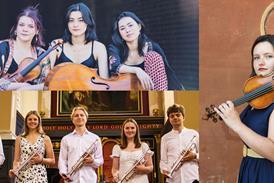- News
- For Subscribers
- Student Hub
- Playing Hub
- Directory
- Lutherie
- Magazine
- Magazine archive
- Whether you're a player, maker, teacher or enthusiast, you'll find ideas and inspiration from leading artists, teachers and luthiers in our archive which features every issue published since January 2010 - available exclusively to subscribers. View the archive.
- Jobs
- Shop
- Podcast
- Contact us
- Subscribe
- School Subscription
- Competitions
- Reviews
- Debate
- Artists
- Accessories
In Focus: A c.1620–1701 viola by Enrico Catenar

Gabriele Rossi Rognoni looks at the German maker’s oldest-known surviving instrument
Enrico Catenar (an Italianisation of Heinrich Casner) is one of the earliest makers known to have been active in Turin in the second half of the 17th century. Recent research published in Claudio Amighetti’s book The Piedmontese Violin Makers in the 17th and 18th Centuries has brought to light several documents highlighting the connection between Catenar and his predecessor Johann Angerer, aka Giovanni Angereri, of whom he was probably an apprentice. Both clearly came from north of the Alps and Catenar declared his origin in several documents, although the identification of his home town (variously spelt as Chislin, Chissigne and Chissigné) is uncertain. It may possibly have been Bad Kissingen. As was usual at the time, Catenar married Angerer’s widow and adopted his two daughters soon after the latter’s death in 1651. He also inherited Angerer’s fortune and workshop.
The viola shown here is the oldest-known surviving instrument by this maker. It was donated to the Royal College of Music (RCM) lending collection before 1914, probably by a Mr Stevens, and was moved to its museum in 1974 on the initiative of the then curator Elizabeth Wells. It was extensively examined in 1978 by Charles Beare, who had first highlighted its importance a few years earlier.
Materials
The belly is made from two pieces of spruce with narrow, regular grain. A 2022 dendrochonology study by John Topham has dated the last ring to the year 1623. The back is of a single piece of maple with no figure. A small fragment of metal, possibly the broken tip of a compass from the drawing stage of the instrument, is inserted in a small hole at mid-length, slightly left of the viola’s centre, visible from the outer surface of the instrument. The ribs are of similar maple to the back, set in a narrow groove carved in the back at c.2.5mm from the edge. Marks of a toothed plane are evident on all of them, internally and externally.
Already subscribed? Please sign in
Subscribe to continue reading…
We’re delighted that you are enjoying our website. For a limited period, you can try an online subscription to The Strad completely free of charge.
* Issues and supplements are available as both print and digital editions. Online subscribers will only receive access to the digital versions.




























